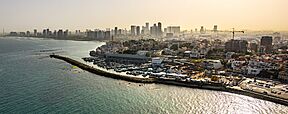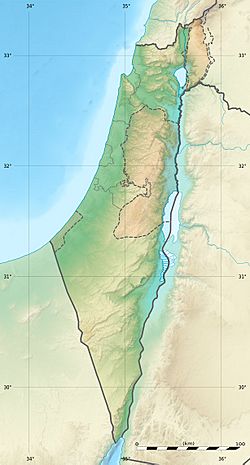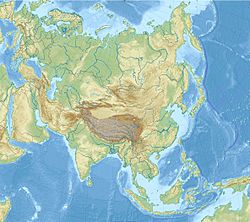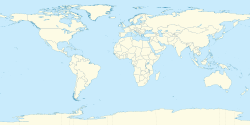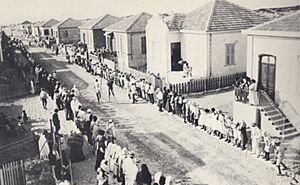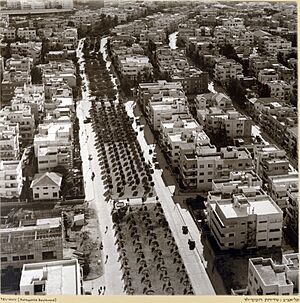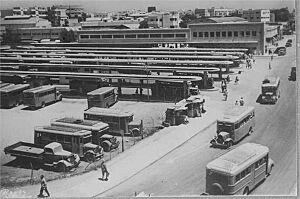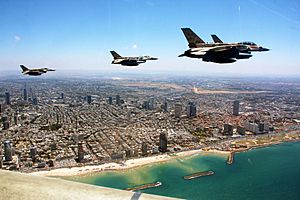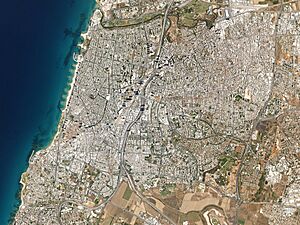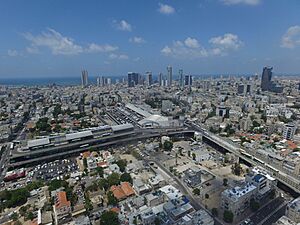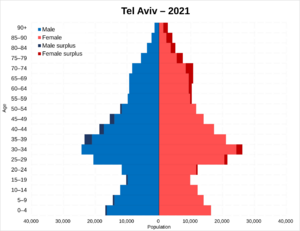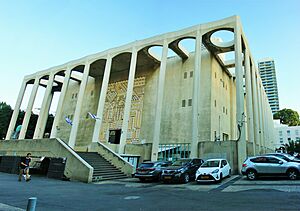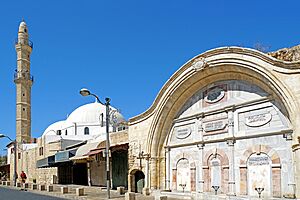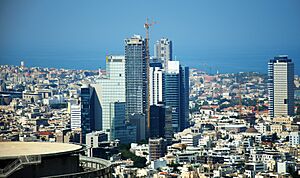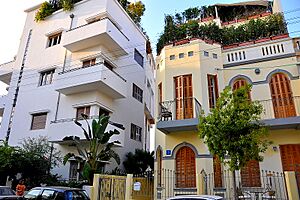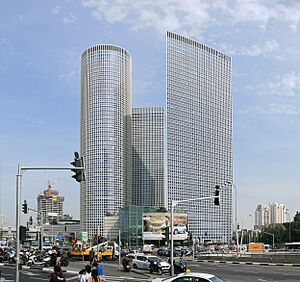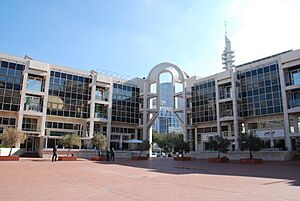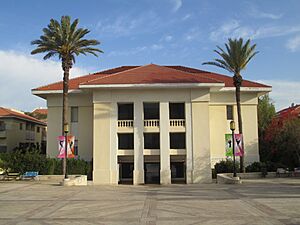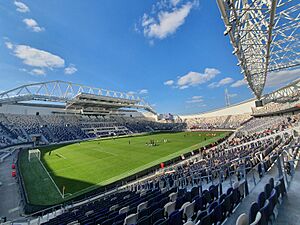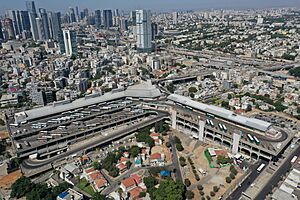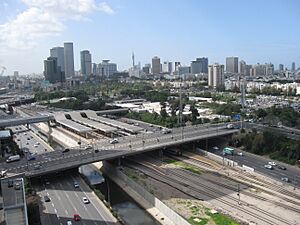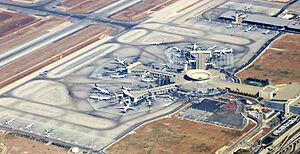Tel Aviv facts for kids
Quick facts for kids
Tel Aviv
|
|||||
|---|---|---|---|---|---|
|
City
|
|||||
| Tel Aviv-Yafo | |||||
|
Skyline of Tel Aviv with Azrieli Sarona and Azrieli Center towers
Rothschild Boulevard
Jaffa Clock Tower
Tel Aviv promenade
Rabin Square and City Hall
Tel Aviv Museum of Art
Old Jaffa and Jaffa Port
|
|||||
|
|||||
Nickname(s):
|
|||||
| Country | |||||
| District | |||||
| Metropolitan area | Gush Dan | ||||
| Founded | 11 April 1909 | ||||
| Named for | Tel Abib in Ezekiel 3:15, via Herzl's Altneuland | ||||
| Government | |||||
| • Type | Mayor–council | ||||
| • Body | Tel Aviv-Yafo Municipality | ||||
| Area | |||||
| • City | 52 km2 (20 sq mi) | ||||
| • Urban | 176 km2 (68 sq mi) | ||||
| • Metro | 1,516 km2 (585 sq mi) | ||||
| Elevation | 5 m (16 ft) | ||||
| Population
(2017)
|
|||||
| • City | 443,939 | ||||
| • Rank | 2nd in Israel | ||||
| • Density | 8,468.7/km2 (21,934/sq mi) | ||||
| • Density rank | 12th in Israel | ||||
| • Urban | 1,388,400 | ||||
| • Urban density | 8,057.7/km2 (20,869/sq mi) | ||||
| • Metro | 4,156,900 | ||||
| • Metro density | 2,286/km2 (5,920/sq mi) | ||||
| Demonym(s) | Tel Avivian | ||||
| Gross Metropolitan Product | |||||
| • Gush Dan | US$310 billion 59% of Israel's GDP (2022) |
||||
| Time zone | UTC+2 (IST) | ||||
| • Summer (DST) | UTC+3 (IDT) | ||||
| Postal code |
61XXXXX
|
||||
| Area code | +972-3 | ||||
| ISO 3166 code | IL-TA | ||||
| Official name: White City of Tel Aviv | |||||
| Type: | Cultural | ||||
| Criteria: | ii, iv | ||||
| Designated: | 2003 | ||||
| Reference #: | [1] | ||||
| Region: | Israel | ||||
Tel Aviv-Yafo (Hebrew: תֵּל אָבִיב-יָפוֹ, romanized: Tēl ʾĀvīv-Yāfō; Arabic: تَلّ أَبِيب – يَافَا, romanized: Tall ʾAbīb-Yāfā), often called just Tel Aviv, is a large city in Israel. It is located on the Mediterranean coast. Tel Aviv is a major center for Israel's economy and technology. It is also a global hub for high-tech companies.
Tel Aviv is governed by the Tel Aviv-Yafo Municipality. Most of Israel's foreign embassies are located here. The city is known as a "beta+ world city" and is ranked high for its financial services. It has one of the largest economies in the Middle East. Tel Aviv is also a top global startup hub. The city is home to Tel Aviv University, which is the largest university in the country.
The city was founded in 1909 by Jewish residents. It was first named Ahuzat Bayit, meaning 'House Estate'. This was a modern housing area built near the old port city of Jaffa. The name was changed to Tel Aviv in 1910. This new name came from a biblical place, meaning "Tell of Spring." This name symbolized new beginnings in the ancient Jewish homeland. Tel Aviv became independent from Jaffa in 1934. Many Jewish refugees moved to Tel Aviv, making it grow very quickly. In 1948, Israel declared its independence in Tel Aviv. The city was the temporary capital until 1950. Later, Tel Aviv and Jaffa were fully joined together as Tel Aviv-Yafo.
Tel Aviv's White City is a UNESCO World Heritage Site. It has the world's largest collection of buildings in the International Style, including Bauhaus designs. Popular places to visit include Old Jaffa, the Eretz Israel Museum, the Museum of Art, Yarkon Park, and the city's beautiful promenade and beach.
Contents
Tel Aviv: A Modern City in Israel
Tel Aviv is a vibrant and modern city in Israel. It's known for its beautiful beaches, lively culture, and as a hub for technology. The city's official name is Tel Aviv-Yafo, combining the new city with the ancient port of Jaffa.
The Meaning Behind the Name
The name Tel Aviv comes from a Hebrew translation of Theodor Herzl’s 1902 novel, Altneuland. The translator, Nahum Sokolow, chose the name from a biblical place mentioned in the Book of Ezekiel.
The word Aviv means "spring" in Hebrew. It represents new life and growth. Tell means an ancient mound built up over time by many layers of old civilizations. So, "Tel Aviv" means "Hill of Spring," showing both ancient history and new beginnings.
When Tel Aviv was founded in 1909, its creators wanted it to be a clean, modern city. They imagined it like European cities such as Warsaw and Odesa. They planned for wide streets, sidewalks, electric lights, and a modern water system.
History of Tel Aviv
Tel Aviv has a rich history, from an ancient port to a modern city.
Jaffa's Ancient Past
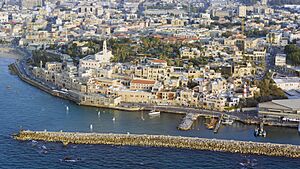
Jaffa is an ancient port city that is now part of Tel Aviv-Yafo. People have lived there since about 7,500 BC. Its natural harbor has been used since the Bronze Age. Over thousands of years, many different groups ruled Jaffa. These included the Egyptians, Philistines, Romans, and Crusaders.
In the 1880s, Jewish immigrants started building new neighborhoods outside Jaffa. The first was Neve Tzedek, founded in 1887. These neighborhoods later joined Tel Aviv when it became a city.
Founding Tel Aviv in the Ottoman Period
![]() United Kingdom 1917–1948
United Kingdom 1917–1948
- Occupied Enemy Territory Administration 1917–1920
- Mandatory Palestine 1920–1948
![]() Israel 1948–present
Israel 1948–present
In 1906, a group of Jewish families formed the Ahuzat Bayit society. They wanted to create a new Hebrew city with good planning and a healthy environment. On April 11, 1909, 66 families gathered on sand dunes. They used seashells to draw lots for their new land. This day is considered the official founding of Tel Aviv.
Streets like Herzl, Rothschild, and Yehuda Halevi were built. A water system was installed, and 66 houses were completed. The Herzliya Hebrew High School, founded in Jaffa, moved to Tel Aviv. The town was first called Ahuzat Bayit. On May 21, 1910, it was officially named Tel Aviv.
By 1914, Tel Aviv had grown a lot. In 1917, during World War I, the Ottoman rulers made people leave Jaffa and Tel Aviv. Most of those expelled were Jewish. They could return after the war when the British took control.
Under British Rule

The British took control of the region in late 1917. Tel Aviv became a "township" within the Jaffa Municipality in 1921. By 1922, Tel Aviv had over 15,000 people, mostly Jewish. By 1925, the population grew to about 34,000.
In 1921, there were clashes between Arabs and Jews in Jaffa. Many Jews then moved from Jaffa to Tel Aviv. Tel Aviv began to grow as a business center. In 1923, it was the first town in Palestine to get electricity.
A city plan was created by Patrick Geddes in 1925. It was based on the "garden city" idea, with green spaces and organized streets. Many buildings in the International Style were built in the 1930s. These were designed by German Jewish architects who came to Palestine.
Becoming an Independent City
Tel Aviv became an independent city, separate from Jaffa, in 1934. Its Jewish population grew quickly as many immigrants arrived from Germany. Tel Aviv became a major urban center. During a period of unrest from 1936 to 1939, a local Jewish port, Tel Aviv Port, was opened. This port was independent of Jaffa.
By 1937, Tel Aviv's Jewish population reached 150,000. This was much larger than Jaffa's population. The city's unique White City area, with its Modernist buildings, developed during the 1930s. It was later recognized as a UNESCO World Heritage Site in 2003.
During World War II, Tel Aviv was bombed by Italian planes in 1940. After the war, Jewish groups launched attacks against British targets in the city. In 1947, the UN Partition Plan suggested dividing Palestine into Jewish and Arab states. Tel Aviv was to be part of the Jewish state, and Jaffa part of the Arab state.
Tel Aviv in the State of Israel
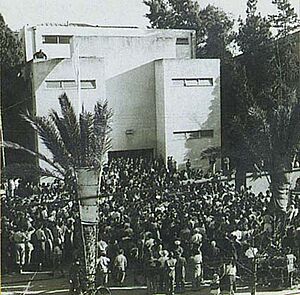
When Israel declared independence on May 14, 1948, Tel Aviv became its temporary government center. The city was bombed by Egyptian planes during the War of Independence. In 1949, parts of Jaffa were joined with Tel Aviv. The unified city was officially renamed Tel Aviv-Yafo in 1950.
In the 1960s, some older buildings were replaced by high-rises. The Shalom Meir Tower, Israel's first skyscraper, was built in 1965. By the 1970s, Tel Aviv's population started to decline. Many families moved to nearby cities for better housing.
However, by the late 1980s, the city began to recover. It became known as the "Nonstop City" for its lively nightlife. Major projects like the Dizengoff Center, Israel's first shopping mall, were built.

In the Gulf War of 1991, Tel Aviv was attacked by missiles from Iraq. The US and Netherlands sent Patriot missiles to help defend the city. In the 1990s, Tel Aviv's population grew again, partly due to immigrants from the former Soviet Union. The city also became a global high-tech center.
New laws were made to protect the city's Modernist buildings. In 2003, Tel Aviv's White City became a UNESCO World Heritage Site. The city also focused on attracting young residents. Old industrial areas like the Tel Aviv Port were turned into fun leisure spots.
Today, Tel Aviv is seen as a major global city. It is known for its modern, liberal, and lively atmosphere. In 2009, Tel Aviv celebrated its 100th birthday.
Geography and Climate
Tel Aviv is located on Israel's Mediterranean coast. It sits on land that used to be sand dunes. The city is mostly flat, with bluffs along the coastline and the Yarkon River mouth. Tel Aviv is about 60 kilometers northwest of Jerusalem.
City Layout and Neighborhoods
Tel Aviv is divided into nine main areas. Jaffa is the oldest part of the city. Neve Tzedek was the first Jewish neighborhood built outside Jaffa. Ramat Aviv in the north has luxury apartments and Tel Aviv University. HaKirya is where the Israel Defense Forces (IDF) headquarters are located.
Rothschild Boulevard is a popular street with wide, tree-lined paths for walking and biking. In recent years, southern Tel Aviv has seen many restoration projects. Neighborhoods like Florentin have become trendy, attracting artists and young people.
Environment and Green Spaces
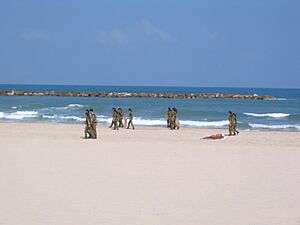
Tel Aviv is considered the greenest city in Israel. It supports environmental efforts like Earth Hour. The city has turned old industrial sites into parks. For example, a former power station is now "Gan HaHashmal" (Electricity Park).
Yarkon Park is the most visited urban park in Israel. Other parks include Charles Clore Park and Meir Park. About 19% of the city's land is green space.
Weather and Seasons

Tel Aviv has a Mediterranean climate, meaning it has sunny, dry summers and mild, wet winters. Most rain falls from October to April. The average yearly temperature is about 20.9°C (69.6°F).
Summers are long, from June to October. August is the warmest month, with highs around 30.6°C (87.1°F). The humidity from the Mediterranean Sea can make it feel even warmer. Winters are mild, with January being the coolest month. Temperatures rarely drop below freezing, and snow is very rare.
| Climate data for Tel Aviv (Temperature: 1987–2010, Precipitation: 1980–2010) | |||||||||||||
|---|---|---|---|---|---|---|---|---|---|---|---|---|---|
| Month | Jan | Feb | Mar | Apr | May | Jun | Jul | Aug | Sep | Oct | Nov | Dec | Year |
| Record high °C (°F) | 30.0 (86.0) |
33.2 (91.8) |
38.3 (100.9) |
43.9 (111.0) |
46.5 (115.7) |
44.4 (111.9) |
37.4 (99.3) |
41.4 (106.5) |
42.0 (107.6) |
44.4 (111.9) |
35.6 (96.1) |
33.5 (92.3) |
46.5 (115.7) |
| Mean maximum °C (°F) | 23.6 (74.5) |
25.0 (77.0) |
30.4 (86.7) |
35.5 (95.9) |
32.4 (90.3) |
30.8 (87.4) |
31.6 (88.9) |
31.8 (89.2) |
32.0 (89.6) |
32.9 (91.2) |
29.2 (84.6) |
23.8 (74.8) |
35.5 (95.9) |
| Mean daily maximum °C (°F) | 17.5 (63.5) |
17.7 (63.9) |
19.2 (66.6) |
22.8 (73.0) |
24.9 (76.8) |
27.5 (81.5) |
29.4 (84.9) |
30.2 (86.4) |
29.4 (84.9) |
27.3 (81.1) |
23.4 (74.1) |
19.2 (66.6) |
24.0 (75.3) |
| Daily mean °C (°F) | 12.9 (55.2) |
13.4 (56.1) |
16.4 (61.5) |
19.2 (66.6) |
21.8 (71.2) |
24.8 (76.6) |
27.0 (80.6) |
27.8 (82.0) |
26.5 (79.7) |
22.7 (72.9) |
17.6 (63.7) |
13.9 (57.0) |
20.3 (68.6) |
| Mean daily minimum °C (°F) | 9.6 (49.3) |
9.8 (49.6) |
11.5 (52.7) |
14.4 (57.9) |
17.3 (63.1) |
20.6 (69.1) |
23.0 (73.4) |
23.7 (74.7) |
22.5 (72.5) |
19.1 (66.4) |
14.6 (58.3) |
11.2 (52.2) |
16.4 (61.6) |
| Mean minimum °C (°F) | 6.6 (43.9) |
7.3 (45.1) |
8.3 (46.9) |
10.7 (51.3) |
14.0 (57.2) |
18.3 (64.9) |
22.2 (72.0) |
23.3 (73.9) |
20.6 (69.1) |
16.2 (61.2) |
10.9 (51.6) |
7.8 (46.0) |
6.6 (43.9) |
| Average rainfall mm (inches) | 147 (5.8) |
111 (4.4) |
62 (2.4) |
16 (0.6) |
4 (0.2) |
0 (0) |
0 (0) |
0 (0) |
1 (0.0) |
34 (1.3) |
81 (3.2) |
127 (5.0) |
583 (22.9) |
| Average rainy days (≥ 0.1 mm) | 15 | 13 | 10 | 4 | 2 | 0 | 0 | 0 | 0 | 6 | 9 | 12 | 71 |
| Average relative humidity (%) (at 1200 GMT) | 72 | 70 | 65 | 60 | 63 | 67 | 70 | 67 | 60 | 65 | 68 | 73 | 67 |
| Mean monthly sunshine hours | 192.2 | 200.1 | 235.6 | 270.0 | 328.6 | 357.0 | 368.9 | 356.5 | 300.0 | 279.0 | 234.0 | 189.1 | 3,311 |
| Source 1: Israel Meteorological Service | |||||||||||||
| Source 2: Hong Kong Observatory for data of sunshine hours | |||||||||||||
| Climate data for Tel Aviv the West Coast (2005–2014) | |||||||||||||
|---|---|---|---|---|---|---|---|---|---|---|---|---|---|
| Month | Jan | Feb | Mar | Apr | May | Jun | Jul | Aug | Sep | Oct | Nov | Dec | Year |
| Record high °C (°F) | 27.7 (81.9) |
31.8 (89.2) |
38.3 (100.9) |
39.1 (102.4) |
38.4 (101.1) |
36.7 (98.1) |
31.7 (89.1) |
32.5 (90.5) |
34.1 (93.4) |
39.5 (103.1) |
34.0 (93.2) |
29.5 (85.1) |
39.5 (103.1) |
| Mean daily maximum °C (°F) | 18.3 (64.9) |
18.9 (66.0) |
20.7 (69.3) |
22.6 (72.7) |
24.4 (75.9) |
27.1 (80.8) |
29.0 (84.2) |
29.9 (85.8) |
29.0 (84.2) |
26.9 (80.4) |
23.9 (75.0) |
20.3 (68.5) |
24.3 (75.6) |
| Daily mean °C (°F) | 14.7 (58.5) |
15.4 (59.7) |
17.2 (63.0) |
19.3 (66.7) |
21.7 (71.1) |
24.7 (76.5) |
26.9 (80.4) |
27.6 (81.7) |
26.5 (79.7) |
23.8 (74.8) |
20.2 (68.4) |
16.6 (61.9) |
21.2 (70.2) |
| Mean daily minimum °C (°F) | 11.1 (52.0) |
11.9 (53.4) |
13.6 (56.5) |
16.0 (60.8) |
18.9 (66.0) |
22.4 (72.3) |
24.7 (76.5) |
25.4 (77.7) |
24.1 (75.4) |
20.7 (69.3) |
16.5 (61.7) |
12.8 (55.0) |
18.2 (64.7) |
| Record low °C (°F) | 4.2 (39.6) |
5.2 (41.4) |
7.2 (45.0) |
10.3 (50.5) |
13.1 (55.6) |
18.8 (65.8) |
21.6 (70.9) |
22.5 (72.5) |
20.1 (68.2) |
15.1 (59.2) |
10.2 (50.4) |
4.0 (39.2) |
4.0 (39.2) |
| Source: Israel Meteorological Service databases | |||||||||||||
| Jan | Feb | Mar | Apr | May | Jun | Jul | Aug | Sep | Oct | Nov | Dec |
|---|---|---|---|---|---|---|---|---|---|---|---|
| 18.8 (65.8) |
17.6 (63.7) |
17.9 (64.2) |
18.6 (65.5) |
21.2 (70.2) |
24.9 (76.8) |
27.4 (81.3) |
28.6 (83.5) |
28.2 (82.8) |
26.3 (79.3) |
23.2 (73.8) |
20.6 (69.1) |
People and Education
Tel Aviv is a city with a growing and diverse population. The average income here is higher than the national average. The city also has high education standards. Many students in Tel Aviv are eligible for matriculation certificates, which are important for university.
Tel Aviv's population reached its highest point in the early 1960s. It then decreased for a while. But since the 1990s, the population has been growing steadily. The city is now attracting many young people and families.
Religious Diversity
Tel Aviv has many active synagogues, including the historic Great Synagogue. There are also churches for diplomats and foreign workers. In 2019, most of the population was Jewish. There are also Arab residents, including Muslims and Christians.
The Jewish population in Tel Aviv comes from all over the world. This includes people from Europe, North America, Africa, and Asia. In recent years, many non-Jewish migrants and refugees have also come to Tel Aviv.
Schools and Universities
Tel Aviv has many schools, from kindergartens to high schools. The city's schools have high success rates for students. New schools and classes are being added to support the growing number of children.
The first Hebrew high school, Herzliya Hebrew Gymnasium, was founded in Jaffa in 1905. It later moved to Tel Aviv. Tel Aviv University is the largest university in Israel. It is known for its strong science and language programs. The university attracts many students from around the world.
Economy and Innovation
Tel Aviv is a very important financial center in the world. It has been called a "flourishing technological center" and a "miniature Los Angeles." The city is a major global hub for high-tech industries. The Tel Aviv area is often called Silicon Wadi, similar to Silicon Valley in the US.
In 2012, Tel Aviv was ranked second globally for starting a high-tech company. In 2013, it was the second most innovative city in the world. The city has hundreds of startup companies and research centers.
Tel Aviv is known for its high cost of living. In 2021, it was named the world's most expensive city to live in. The city has many shopping malls, like Dizengoff Center and Azrieli Shopping Mall. It also has popular markets like Carmel Market.
The Tel Aviv Stock Exchange (TASE) is Israel's only stock exchange. Many international investment firms and high-tech companies have their main offices in Tel Aviv. The city is ranked as a top global startup ecosystem.
Tourism and Fun Activities
Tel Aviv welcomes about 2.5 million international visitors every year. It is one of the most visited cities in the Middle East. It has been called one of the "hottest cities" and a top beach city in the world.
Tel Aviv is famous as "the city that never sleeps" because of its lively nightlife. It has many hotels, museums, and cultural sites. You can take different tours to explore the city.
The city's beautiful beaches are a big part of its culture and tourism. They are often ranked among the best beaches in the world. Yarkon Park is Israel's most visited urban park.
Culture and Arts
Tel Aviv is a major center for culture and entertainment in Israel. Many of the country's main performing arts centers are located here.
City Architecture
Tel Aviv has many different building styles. Early houses were European-style with red roofs. Neve Tzedek has two-story sandstone buildings. In the 1920s, an "eclectic Orientalist style" became popular. This mixed European and Eastern designs.
The Bauhaus school of architecture greatly influenced Tel Aviv. Many German Jewish architects came to Palestine in the 1930s. Tel Aviv's White City has over 5,000 Modernist buildings inspired by Bauhaus. These buildings are now a UNESCO World Heritage Site.
The Shalom Meir Tower, built in 1965, was Israel's first skyscraper. In the 1990s, many more skyscrapers were built, changing the city's skyline. The city plans to build even more skyscrapers in the eastern parts of Tel Aviv.
Art and Museums
Tel Aviv became a center for art in Israel in the 1920s. Artists were influenced by the School of Paris. They painted the city's landscapes and people. Tel Aviv has the Tel Aviv Museum of Art and many other galleries.
Israel has the most museums per person in the world. Three of the largest are in Tel Aviv. These include the Eretz Israel Museum, which focuses on archaeology and history. The ANU - Museum of the Jewish People tells the story of Jewish people around the world.
Entertainment and Shows
Tel Aviv is a major hub for culture and entertainment. It has many theaters and performing arts centers. The Tel Aviv Performing Arts Center is home to the Israeli Opera. The Heichal HaTarbut is the city's largest theater and home to the Israel Philharmonic Orchestra.
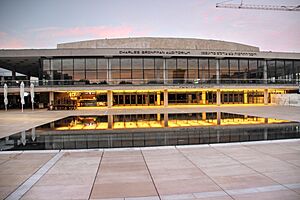
Habima Theatre, Israel's national theater, is also in Tel Aviv. The city is home to the Batsheva Dance Company, a famous modern dance group. The Suzanne Dellal Center is a major dance center.
Tel Aviv often hosts international musicians. The city hosted the Eurovision Song Contest 2019. The Tel Aviv Cinematheque shows art films and hosts film festivals.
Tel Aviv is known for its active nightlife. It has many bars, dance clubs, and nightclubs that stay open late. The Tel Aviv port area is popular for large clubs.
Fashion and Media
Tel Aviv has become an international center for fashion and design. It hosted its first fashion week in 2011.
The three largest newspaper companies in Israel are based in Tel Aviv. Many radio stations and the two major Israeli television networks are also located here.
Food and Cuisine
Tel Aviv is famous for its many world-class restaurants. They offer traditional Israeli dishes and international food. The city has a very high number of sushi restaurants. A special dessert here is Halva ice cream, often topped with date syrup and pistachios.
Sports in Tel Aviv
The city has several football stadiums. The largest is Bloomfield Stadium, used by Hapoel Tel Aviv and Maccabi Tel Aviv. The Menora Mivtachim Arena is a large indoor sports venue.
The Maccabi Tel Aviv Sports Club was founded in 1906. Its basketball team, Maccabi Tel Aviv Basketball Club, is famous worldwide. Its football team has won many Israeli titles.

The Hapoel Tel Aviv Sports Club also has many teams, including football and basketball. Tel Aviv also has rowing clubs and hosts an annual Tel Aviv Marathon.
Getting Around Tel Aviv
Tel Aviv is a major transportation hub. It has a good public transport system. Many main roads and routes run through the city.
Buses and Taxis
Buses are the most common way to get around. The Tel Aviv central bus station is in the southern part of the city. Several bus companies operate in the area.
Shared taxis, called "sherut taxis," also run on many bus routes. They are often cheaper than private taxis. Unlike buses, these taxis operate on weekends and Jewish holidays.
Trains and Light Rail
The Tel Aviv Savidor Central railway station is the city's main train station. Tel Aviv has five other train stations along the Ayalon Highway. Trains do not run on Saturdays or major Jewish festivals.
The Tel Aviv Light Rail is a new public transport system. The first line, the Red Line, opened in 2023. More lines are being built. A subway system, the Tel Aviv Metro, is also planned for the future.
Roads and Cycling
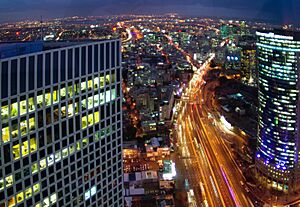
The main highway in Tel Aviv is the Ayalon Highway. It runs from north to south through the city. Other important roads include Kaplan Street and Rothschild Boulevard. Tel Aviv can get very busy with traffic.

The city encourages people to use bicycles. Tel Aviv has over 140 kilometers of bike paths. The city also has a bike-sharing system called Tel-O-Fun.
Airports
The main airport for Tel Aviv is Ben Gurion International Airport. It is located near the city of Lod. It is Israel's busiest airport.
Tel Aviv's Global Connections
Tel Aviv has agreements with many cities around the world. These agreements help promote friendship and cooperation.
| City | Country | Continent | Year of signing | Type of agreement |
|---|---|---|---|---|
| Kazakhstan | Asia | 1999 | twin cities | |
| Spain | Europe | 1998, ratified in 2013, revoked and restored in 2023 | friendship and collaboration | |
| China | Asia | 1995, 2004, 2006 | understanding, friendship and collaboration | |
| Serbia | Europe | 1990 | collaboration | |
| Germany | Europe | 1983 | collaboration | |
| Hungary | Europe | 1989 | collaboration | |
| Argentina | South America | 1988 | twin cities | |
| France | Europe | 1993 | friendship | |
| Moldova | Europe | 2000 | twin cities | |
| China | Asia | 2014 | Memorandum of understanding | |
| Germany | Europe | 1979 | collaboration | |
| Germany | Europe | 1992 | collaboration | |
| Germany | Europe | 1980, expanded in 2017 | collaboration | |
| Germany | Europe | 2012, 2015 | Memorandum of understanding for sustainability, collaboration | |
| Palestine | Asia | 1999 | Sister cities agreement | |
| China | Asia | 2014 | Memorandum of understanding | |
| South Korea | Asia | 2000 | twin cities | |
| Turkey | Asia | 1996 | twin cities | |
| Poland | Europe | 1994 | collaboration | |
| Italy | Europe | 1994 | twin cities | |
| Canada | North America | 2016 | friendship | |
| Russia | Europe | 2014 | Memorandum of understanding for economic, trade, scientific, technological and cultural fields | |
| United States | North America | 1996 | understanding, friendship and collaboration | |
| Panama | North America | 2013 | friendship | |
| France | Europe | 1985, expanded in 2010 | collaboration | |
| United States | North America | 1967 | twin cities | |
| Russia | Europe | 2011 | collaboration | |
| United States | North America | 2011 | friendship | |
| Bulgaria | Europe | 1992 | twin cities | |
| Greece | Europe | 1994 | twin cities | |
| France | Europe | 1962 | twin cities | |
| Austria | Europe | 2005 | economic collaboration | |
| Poland | Europe | 1992, 2009 (education collaboration) | collaboration | |
| Japan | Asia | 2012 | friendship |
See also
 In Spanish: Tel Aviv para niños
In Spanish: Tel Aviv para niños








